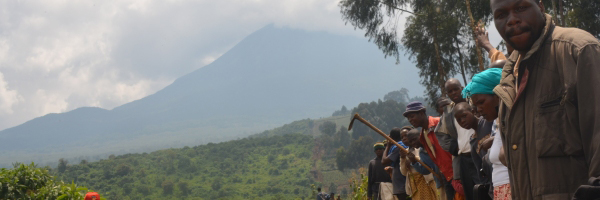Being Neighborly in the Virunga Massif

The Virunga Massif is divvied up among three countries, and there is a place in the Massif where Rwandan farmland abuts a Congolese park. On any given day, there is conflict.
But this conflict is not between people. It is between farmers and wildlife, as forest buffalo and forest elephants leave the park to feast on potatoes or maize. This is what we call human-wildlife conflict, and it is best to be prevented or it can spur anger and downright hatred for wildlife and the conservation efforts to preserve them and their habitat. Understandable, because to these farmers, their crops are worth more to them than an elephant or a buffalo, even a mountain gorilla.
In November 2011, forest elephants, who move through the transboundary Virunga Massif, raided the crops in this area, and blame was quickly pointed across the border. Rwanda's New Times newspaper reported, "Residents of Bugeshi Sector in Rubavu District have seen their prospective harvests slashed by almost Rwf 2 million after stray elephants from the neighbouring Democratic Republic of Congo destroyed their crops. The elephants often cross into the district from the DRC's Virunga national park, where they are not properly watched over." Obviously, this kind of fingerpointing is not good for transboundary relationships.
While the trench is not much to look at, it is being applauded by farmers neighboring the park.
Fast forward to 2012 and a new trench is being dug thanks to support from the Norwegian Embassy in Uganda via the Greater Virunga Transboundary Collaboration and implemented on the ground through IGCP, with the two parks and community organizations from the two countries. The trench, almost 2 km long and completed last week will serve as a reinforcement to the stone buffalo wall that is there. The trench is specifically meant to deter forest buffalo, the usual crop-raiding culprits from accessing neighboring fields. And recently, Rwanda's New Times again reported about this issue, but this time the story was about grassroots transboundary collaboration to find a solution to the crop raiding issue.
IGCP's Benjamin Mugabukomeye checks on the progress of the trench dug to prevent forest buffalo from leaving the park and raiding nearby potato fields.
The International Gorilla Conservation Programme has long played a role in reducing human-wildlife conflict, working in partnership with park management and local communities. Methods have included (and still include) building of the stone buffalo walls around the Virunga Massif and continued efforts to reinforce it, supporting Human-Gorilla Conflict Resolution teams (HuGo teams), advocating for and supporting the collection of monitoring data on wildlife outside of the parks, and in Bwindiís case, the establishment of a buffer zone in Nkuringo. Lessons learned from these efforts were recorded in 20 Years of IGCP: Lessons Learned in Mountain Gorilla Conservation (click to view/download the PDF).
Photos courtesy of J. Damascene Hakuzimana/GVTC.